Hello everyone:
I wrote the first version of this essay a few years ago, when the Field Guide was new and subscribers were few. Here it’s rewritten and updated for a much larger crowd.
As always, please remember to scroll past the end of the essay to read this week’s curated collection of Anthropocene news.
Now on to this week’s writing:
As winter fades from memory, we in the northern hemisphere are entering roadkill season. Roads kill year-round, of course, but as life increases and reproduces so does the body count. Around here, frogs, toads, and salamanders chose damp nights in early spring to seek love in the wetlands on the other side of the roads. A little later, snakes sidled into busy lanes for sunny warmth on cool days. Migratory songbirds traveled their long and ancient spring journeys to our neighborhoods before flitting across traffic for nest material. More recently, porcupines, skunks, squirrels, and so many of our other neighbors began to go about their errands on a land booby-trapped by asphalt death zones. Their young are next.
As Ben Goldfarb notes in his astonishing new book, Crossings: How Road Ecology is Shaping the Future of Our Planet, the U.S. alone has about 4 million miles of roads, and every year - every year - more than one million vertebrates die on the paved and gravel paths we’ve built for our cars and trucks. Roads kill more creatures than anything else we do. And we scarcely notice. “More birds,” he writes,
die on American roads every week than were slain by the Deepwater Horizon oil spill, with the road deaths accompanied by a fraction of the hand-wringing.
This past Tuesday, during a five-minute drive, I removed from the road the smashed carcasses of a vivid American redstart and three beautiful painted turtles. We had a heavy spring rain the night before, and the green and buzzing world felt especially vibrant and humid as the sun coaxed some of the water back from the soil. I imagined, as I scraped them off the pavement, that the redstart had been feeding its young and the painted turtles had cheerfully tottered out onto the tar from the dampness of creation.
If this is the fate of the animals we see, how much worse might it be for those we don’t? I’m talking about insects flattened under our wheels and splattered across our windshields and grills. Ironically, though, what is so worrisome about insect roadkill is not the evidence of death but the lack of it.
This time of year, I often think about the lack of dead insects on my car. Like many of you who grew up in the 20th century, I remember the windshields of my childhood station wagons and teen junkers were often smeared with the white or yellow spots of insect hemolymph (their blood equivalent), and that chrome crevices were crusted with the bodies and wings of damselflies, bumblebees, butterflies, and wasps. Left to dry, these vehicular homicides stuck like glue.
For me, this rarely happens anymore.
It turns out that I’ve been way behind the curve on noticing the lack of dead bugs on my cars. It’s been a common observation and a discussion point for since the late 20th century. It has a name: the Windshield Phenomenon (or Windscreen Phenomenon in the UK). It sounds like nostalgia – You should have seen the dirty windshields when I was a kid! – but entomologists and ecologists as well as truck drivers and writers like me have the same anecdotal suspicion: there are far fewer bugs turning into mush on our vehicles.
Suggestions that today’s more aerodynamic cars are less likely to hit flying insects (including what Barry Lopez called “the aerial plankton of spiders and mites”) are not supported by the data. A UK study that outfitted cars with “splatometers” found that modern cars caught slightly more bugs than older, chunkier ones. And a German entomologist, Martin Sorg, told Science in 2017: "I drive a Land Rover, with the aerodynamics of a refrigerator, and these days it stays clean.”
I imagine that the main reason my parents bought wiper fluid in the summer was to try to erase, pump after pump, those smears that blinded us as they caught the afternoon sun. And do some of you remember how when you had your arm out the window, riding the slipstream, you’d often feel the sting of a small exoskeleton bullet?

You know where I’m going with this. While we fret about avoiding our own apocalypses, it’s worth talking about how insects are already suffering theirs. The two concerns are not separate, of course, since a) we’re the cause of their decline, and b) insects more or less run the planet. As E.O. Wilson famously said,
If all mankind were to disappear, the world would regenerate back to the rich state of equilibrium that existed 10,000 years ago. If insects were to vanish, the environment would collapse into chaos.
Nearly one million insect species have been identified, but the actual number may be as high as 10 million. Depending on what that number is, insects may comprise 70% to 90% of all animal species. There are about 1.4 billion insects for every person on Earth, which adds up to a biomass about 70 times greater than that of humans. At a glance, then, Earth would seem to be an ocean planet whose continents are run by plants and insects, and lightly ornamented with a minority of much larger species we like to call charismatic megafauna, hoping that the term also describes us.
But this insect dominion, which has held sway for hundreds of millions of years, has weakened in the Anthropocene, this new era in which humans are haphazardly altering the conditions for life on Earth. Wetlands, grasslands, and forests are disappearing rapidly; monocultural agriculture has spread like wildfire through formerly diverse habitats; pesticide and herbicide use is rampant and often indiscriminate; invasive species we’ve introduced wreak havoc with native insects and their host plants; and a hotter world is rapidly unraveling ecosystems in a myriad of unpredictable ways.
Where insects go, we will follow. A decline in the complexity of life is inevitably a decline in the quality of human life. Remember that ecosystems are systems rather than objects. They are lush sets of relationships between species, and between those species and environmental conditions. As we impoverish conditions, then, we impoverish those relationships, which means we impoverish the systems we rely on.
This is the part of the essay where you might expect me to highlight the importance of pollinators for human agriculture, and I will, but please remember that focusing on pollinators is the self-interested equivalent of motivating wealthy Americans to worry about climate change because it might impact their shorefront property value.
Insects are essential for the planet’s food webs, both terrestrial and freshwater. Sure, they pollinate pretty much everything that flowers (including nearly three quarters of our agricultural plants), but they also cycle nutrients, break down decaying matter, disperse seeds, enrich and maintain soil structure, regulate populations of other organisms, and provide a major food source for much of the world’s animal life.
As the cute bees, moths, and butterflies (and less cute flies, wasps, mosquitoes, and ants) who make our food and flowers grow, pollinators are often the only acceptable group of insects for the nature-averse residents of a shiny new civilization (that’s us) who no longer see nor understand the value of creatures whose history on Earth stretches back 480 million years.
We cower when a wasp enters a room and is helplessly looking for a way out. In 2020, we spent $7.36 billion dollars globally on household and garden pesticides. (That was nearly one dollar for every human on the planet.) One EPA survey found that 75% of U.S. households had used at least one pesticide indoors that year. To be honest, I’m surprised that number isn’t higher.
Most of us know little about insects, other than that some sting, some visit flowers, and some enter our homes and make us uncomfortable enough to reach for broad-spectrum poisons. Though I often found them marvelous, beautiful, interesting, or occasionally spooky (looking at you, parasitic wasps) I didn’t pay them close attention until recent years. Now I get a kick every time I open up the field guide, Insects of New England and New York, to a random page to find the Rosy Maple Moth, the Dogbane Beetle, or the Thread-waisted Wasp. Each is astonishing in its design, and each represents a fragment of a largely unknown world which, I should note, is the real world.
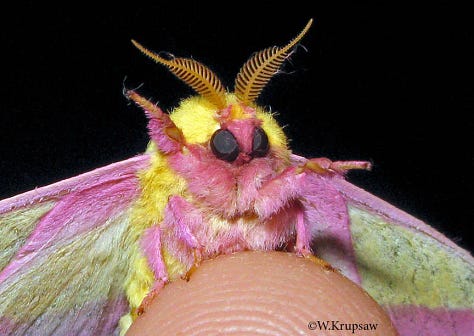
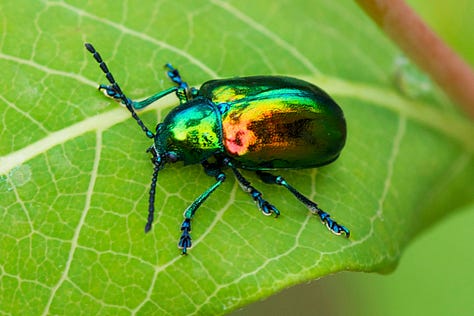

We are far more attuned to economies than ecologies, partly because one has literally consumed the other, and partly because we’re self-absorbed social primates who in recent centuries have constructed a society so unnatural that it treats other species as foreign invaders rather than as fellow travelers.
Even environmentalists are forced these days, in the uphill battle to protect remnant populations of plants and animals, to discuss them in terms of their “ecosystem services,” a grossly shallow economic term which is both redundant – since without insects, for example, there would be few ecosystems – and a failure of empathy and imagination. We have forgotten what it means to be grateful to the plants, animals, and landscapes that give us life. We are like cows who are dismissive of the grass.
Our ignorance of the natural world, writes Robin Wall Kimmerer, has consequences:
Ethnobiologists tell us that our great-grandparents spoke fluent natural history. They knew the names and personalities of dozens of birds and hundreds of plants. Today the average American schoolchild can recognize more than a hundred corporate logos. They can give a name to about ten plants, and these include such categories as “Christmas Tree” and “Grass.” We have lost an entire vocabulary, of speech, of experience, and of relationship. Our fundamental currency of relationship, our highly evolved capacity for paying attention to those species who sustain us, has been subverted in a kind of intellectual hijacking. How can we care for them, monitor their well-being, and fight for their existence if we don’t even know their names?
Which brings us to the possibility of an ongoing “insect Armageddon” or “insect apocalypse.” Type in those search terms and a plethora of media articles will pop up. A 2021 New Yorker article by Elizabeth Kolbert shared its title (“Where Have All the Insects Gone?”) with a 2017 Science article by Gretchen Vogel. Both are excellent. Also in 2021, a book by UK ecologist Dave Goulson, Silent Earth: Averting the Insect Apocalypse, summarized the evidence and the threats before making an impassioned plea for civilization to remedy the situation.
In Crossings, Ben Goldfarb looks at the insect decline from behind the wheel:
The apocalypse is both exacerbated by roads - cars kill billions of North American pollinators every year - and revealed by them. Like mobile natural-history museums, windshields once showcased the exuberance of the invertebrate world, its blizzards of moths and midges. Now our cars remain spotless, and gas-station squeegees sit useless in their soapy buckets.
Discussion of the “insect apocalypse” in the media – to the extent they’ve paid attention – was sparked by data from the Krefeld Entomological Society, a group of largely amateur German scientists, and by a 2019 paper, “Worldwide decline of the entomofauna: A review of its drivers.” The Science article I note above focuses on the Krefeld story, which amounts to this: insect traps set in more than a hundred nature reserves around Western Europe, where insect populations have been measured by the group for decades, showed that numbers had dropped in numerous locations by 75%. (There’s a great New York Times profile of the Krefeld amateurs, among them a schoolteacher, a physicist, an engineer, and some teenagers.)
The “worldwide decline” paper, billed as a comprehensive review and meta-analysis of global data on insect abundance and diversity over time, suggested that insects are going extinct eight times faster than mammals, reptiles, and birds, and that insect biomass declines by 2.5% every year. The study offered five key takeaways:
Over 40% of insect species are threatened with extinction.
Lepidoptera [butterflies and moths], Hymenoptera [sawflies, wasps, bees, and ants], and dung beetles (Coleoptera) are the taxa most affected.
Four aquatic taxa are imperiled and have already lost a large proportion of species.
Habitat loss by conversion to intensive agriculture is the main driver of the declines.
Agro-chemical pollutants, invasive species and climate change are additional causes.
But this is where the insect decline narrative hits a speedbump. For a good scientific rebuttal to the idea that windshield observations amounts to evidence, or whether there’s sufficient data to declare a global insect decline underway, check out these five posts by Australian ecologist Manu Saunders at her blog, Ecology is Not a Dirty Word. Saunders is understandably tough in her assessment of what passes for good science and good scientific conclusions because, to maintain public trust, it’s crucial that science remains objective and honest.
In the “insect apocalypse” and “windshield phenomenon” stories, Saunders sees a mess of random observations without consistency or parameters; she sees confirmation bias, since online discussions of bugless windshields generate discussion while contrary observations of heavily splattered windshields are largely ignored; and she sees flaws in studies that cannot properly account for a) insect populations in many regions of the Earth where data simply don’t exist, b) natural changes in insect abundance over long periods, or c) the natural history of the vast majority of insects we know little to nothing about.
In other words, generalized observations of the state of global insect populations are nearly impossible to make with confidence, because the data are skimpy across time, continents, and numbers of species.
What we do know, she says, is that while there’s good specific evidence of local or regional declines (as with the Krefeld data), “trends vary widely across taxa and locations.” Some studies have noted increases of certain insect populations, though some of these may be due to our interference, e.g. pesticide use or habitat loss which reduced their insect predators.
Moreover, she says, “focusing on a hyped global apocalypse narrative distracts us from the more important insect conservation issues that we can tackle right now. Promoting this narrative as fact also sends the wrong message about how science works, and could have huge impacts on public understanding of science.” She is particularly critical of the “worldwide decline” paper, which she found so full of flaws that “it really shouldn’t have been published in its current form…” The key finding of projected extinctions for 40% of insect species she calls “bizarre,” since “we don’t even have population data for 40% of the world’s insect species.” And she notes, despite the paper’s claim to be both a comprehensive review and a meta-analysis, it was neither.
Saunders is in good company. The Entomological Society of America released a statement (pdf download) in response to the media hubbub over the “worldwide decline” paper that echoed her concerns, noting that extinction predictions “extended well past the limits of the data or have been otherwise over-hyped,” and that good data is particularly absent for “arctic and tropical regions and a majority of the southern hemisphere.” That’s most of the planet.
That said, the ESA and Saunders are both deeply aware of the widespread threats to insects and actively working to understand them. The threats are, of course, likely to be the same threats that are severely reducing populations of mammals, birds, and other charismatic vertebrates. There’s habitat loss, climate change, the overuse of pesticides and other synthetic chemicals, invasive species, light pollution, etc. But they urge that scientific communication about the vitally important story of what’s happening to insects should be based on hard science.
This is tricky, though. Science in general has innumerable data points that describe a planet that’s been overused, upended, poisoned, declining in diversity, and rapidly changing in ways seen only during Earth’s few mass extinctions. The rapidly increasing mass of human infrastructure might as well be a flaming shopping-mall-sized meteor entering the atmosphere. The Anthropocene, which describes this state of affairs, is a term derived from sufficient data to identify an incredible deep and broad set of changes (some reversible and some not) made to the community of life by our species. There is much we do not know, but we know enough.
Even if science doesn’t have clear, robust data to support the insect apocalypse story in a vigorous way, don’t we have enough information to assume it’s happening? If vast swathes of wetlands and grasslands and forests have disappeared, then aren’t their insect inhabitants disappearing too? Doesn’t a world of clean windshields mean something in the Anthropocene?
Science doesn’t assume, I know, or at least it does so carefully and honestly. Ideally, to understand the state of Earth’s insects, these assumptions about severe population decline would be tested in a global suite of comprehensive studies, each well-funded and run over many years. But we don’t have that kind of time in the 21st century, and most of that funding will not be forthcoming. Much will have to be made of scant data, despite the wishes of good ecologists. For example, here’s an excellent and rational blog post from an expert at the Xerces Society that explains what must be done to support insect populations even if the data isn’t great.
This brings me to one of the questions which haunt this Field Guide. What is the role of science in Anthropocene culture? We like to think that civilization is centered around science, but in fact it’s centered around markets which farm science for potential profits. We love science that enriches our lives but balk at science that challenges our thinking, as the iPhone-carrying anti-mask and anti-vax protestors can attest. We hope science will guide us out of the climate and biodiversity crises but not if the data tells us (as it certainly does) to shop less, reduce our energy and resource footprints, simplify our lives, and change our diets.
I’m struck by the levels of blindness in this insect decline story. Why didn’t I notice the windshield phenomenon until a few years ago? Why don’t we recognize, respect, and protect the basic functions invertebrates provide to the living world? The answer, I suppose, is that we don’t know enough about insects because we haven’t invested enough to gain that knowledge. “We have a pretty good track record of ignoring most noncharismatic species,” says entomologist Joe Nocera in the Science article. Entomologists are themselves rare creatures, and growing rarer.
In other words, we don’t know much about the insect kingdom that surrounds us, and we don’t know much about how we’ve stormed the castle. But it must be changing, because everything else is.
So how should science talk about it? Should it lean toward the language of activism? Manu Saunders says that a basic principle of science communication is that “Awareness is not the same as engagement or participation… Awareness does not always lead to action, and conservation action that is not evidence-based can do more harm than good,” including eroding public trust in science.
Contrast this, though, with Robin Wall Kimmerer’s philosophy that “Attention becomes intention, which coalesces itself to action.” If we attend to the real world and see both the beauty and the harm, we’re empowered to act.
So it will come down to our desire to see the world as it truly is, and it will come down to our response to what we see. And indeed, all the public noise in response to the flawed “worldwide decline” report motivated the Entomological Society of America to hold a symposium with the goal to
assemble world experts on insect biodiversity and conservation and ask them to report on the state of knowledge of insect population trends. Speakers were asked to identify major data gaps, call attention to limitations of existing data, and evaluate principal stressors underlying declines, with one goal being to catalyze activities aimed at mitigating well-substantiated declines.
That sounds to me like a classic story of attention becoming action.
Here in our own lives we can take some action too. Work to ban the sale and use of neonicotinoid pesticides wherever you live, at the state and local level. Help preserve large-scale habitats. Clean up freshwater streams and ponds. Encourage farms and public green spaces to reserve diverse habitat for the preservation of a diverse array of insects. Become a devoted amateur entomologist and focus on, say, parasitoid wasps, of which there are merely 650,000 species. Keep a wide-mouthed jar and lid handy for catching and taking outside the spiders and insects that get trapped in your house.
Plant pollinator gardens. Turn off outside lights whenever and wherever possible, and advocate for Dark Sky-quality lighting in your community. And remember, as a recent Guardian article on the importance of green spaces in urban places noted, that “habitat loss” is a euphemism: “We cry habitat loss, but it’s theft, really – no [animal] is so careless as to lose their home.”
That should keep you busy. As a reminder of the fascinating beauty that’s at stake, here are a few more deliciously-named characters from Insects of New England and New York. Remember that this is what exists on the other side of our windows and windshields:
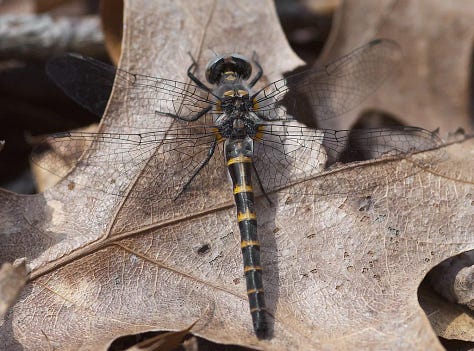
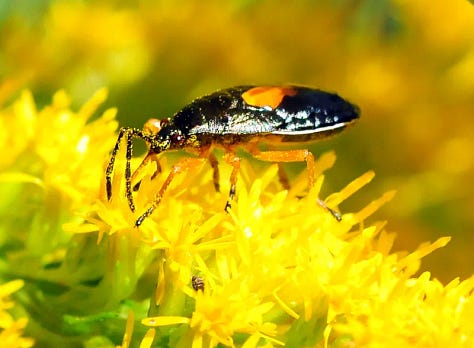
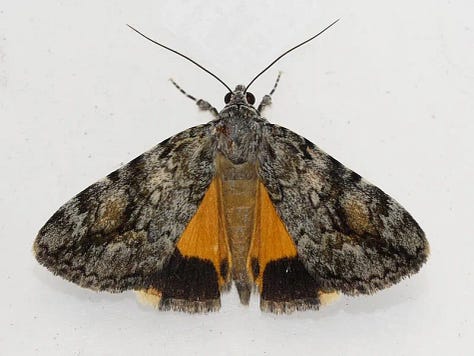
Thanks for sticking with me.
In other Anthropocene news:
From Slate, “We’re All Roadkill Now,” another great article by Ben Goldfarb linked to his new book, Crossings: How Road Ecology is Shaping the Future of Our Planet. In this article, Goldfarb lays out the scale of destruction and disruption roads and vehicles cause in both the natural world and human society, and he does it with his usual brilliant wit. For example: “In the Sixth Extinction, the asteroid is an F-150,” he writes, and “We made our bed of asphalt; now we’re lying in it.” It’s a good reminder that some of the one million vertebrates dying every day on our 4 million miles of roads are us.
From Bryan Pfeiffer and
, a really wonderful tribute to Rachel Carson on her birthday, and a contemplation of how her work might be received if it emerged in today’s world.From Yale e360, a promising set of technologies are making it possible to extract valuable minerals (i.e. lithium, magnesium, copper, and zinc) from seawater, desalinization brine, and other industrial brines. The benefits include 1) avoiding the destruction of ordinary ore mining, 2) turning the toxic waste brine into a valuable commodity, and 3) setting the stage for a circular economy that involves providing fresh water and powering a clean energy future. One of the researchers interviewed for the article said that, in principle, “there is no such thing as wastewater.” The brine from desalinization plants around the world contains an estimated $2.2 trillion in unused minerals.
From the Guardian’s extraordinary Age of Extinction coverage, “The Biodiversity Crisis in Numbers: A Visual Guide,” an explainer article on the loss of biodiversity across the Earth because of human activity. It’s a really great place to start if you want to get a handle on why we talk about a “biodiversity crisis” and what’s at stake as the fabric of life unravels.
From the Atlantic, my favorite truths about understanding the Earth’s climate: clouds are still mysterious.
From Vox, global greenhouse gas emissions may have peaked in 2023. It’s a good, comprehensive article. Also, here’s a graph from BloombergNEF:

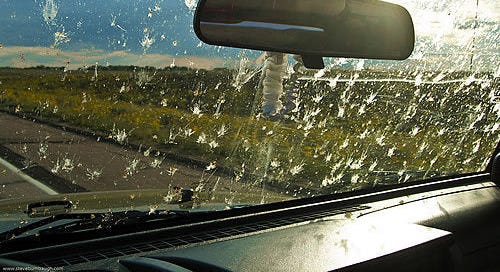






In my mind right now as I read this: why do we need to travel so much? And why do we need to get there faster?
We're hurrying to get somewhere, ignoring what we have where we are.
Roads are a very good idea when there are but a few of them. Yheycarexs very bad idea when there are millions of them. It's all a scale phenomena and knowing when enough of something has been reached and it's time to stop. Our own human population is just the same. A billion of us is enough. Eight billion of us is very bad news for the planet.
We need to voluntarily reduce our numbers and re-wild as much of the planet as we can.
I doubt there's the will. I don't doubt that even if there were the will, we could put the horses of global heating back in the barn.